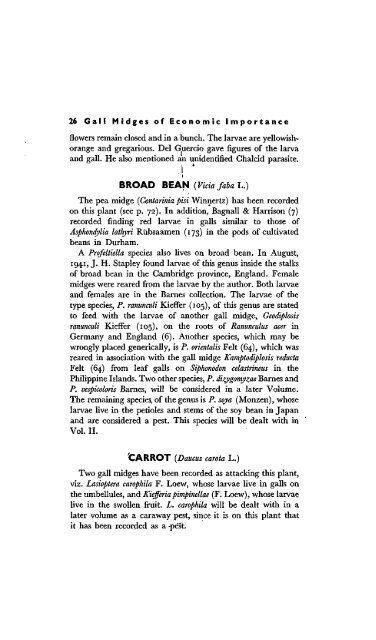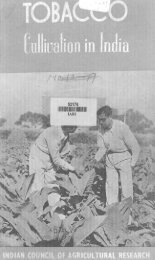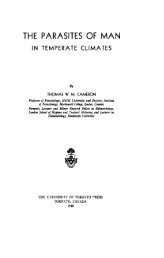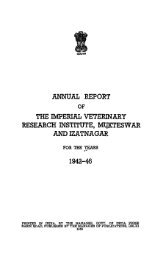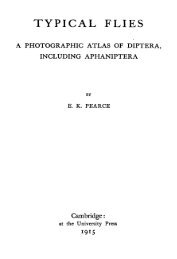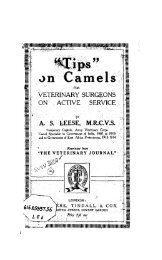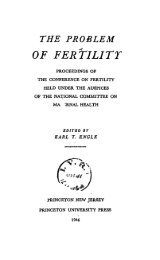26 Gall Midges of Economic importanceflowers remain closed and in a bunch. The larvae are yellowishorangeand gregarious. Del Guercio gave figures of the larvaand gall. He also mentioned an unidentified Chalcid parasite.I *BROAD BEAti{Vicia faba h.)The pea midge {Contarinia pisi Winnertz) has been recordedon this plant (see p. 72). In addition, Bagnall & Harrison (7)recorded finding red larvae in galls similar to those ofAsphondylia lathyri Riibsaamen (173) in the pods of cultivatedbeans in Durham.A Profeltiella species also lives on broad bean. In August,1941, J. H. Stapley found larvae of this genus inside the stalksof broad bean in the Cambridge province, England. Femalemidges were reared from the larvae by the author. Both larvaeand females are in the Barnes collection. The larvae of thetype species, P. ranunculi KiefTer (105), of this genus are statedto feed with the larvae of another gall midge^ Geodiplosisranunculi KieflFer (105), on the roots of Ranunculus acer inGermany and England (6). Another species, which may bewrongly placed generically, is P. orientalis Felt (64), which wasreared in association with the gall midge Kamptodiplosis reductaFelt (64) from leaf galls on Siphonodon celastrineus in thePhilippine Islands. Two other species, P. dizygomyzac Barnes andP. vespicoloris Barnes, will be considered in a later Volume.The remaining species, of the genus is P. soya (Monzen), whoselarvae live in the petioles and stems of the soy bean in Japanand are considered a pest. This species will be dealt with inVol. II.CARROT {Daucus carota L.)Two gall midges have been recorded as attacking this plant,viz. Lasioptera carophila F. Loew, whose larvae live in galls onthe umbellules, and Kiefferiapimpinellae (F. Loew), whose larvaelive in the swollen fruit. L. carophila will be dealt with in alater volume as a caraway pest, since it is on this plant thatit has been recorded as a -pest.
Gall Midges of Economic Importance 27Kiefferia pimpinellae (F. Loew, 1874), the Carrot GaU Midge,*syn. pericarpiicola Bremi, 1847 (laiva and gall only), dauci' Bremi, 1847(larva and gall only), umbellatarum F. loew, 1877.DIAGNOSTIC CHARACTER. Swollen fruit, standing out wellabove the inflorescence, of Carrot and Parsnip.DAMAGE. The fruits become reddish or violet in colour andhave a tendency to lose their normal shape and spines. As aresult of an infestation no seed is formed.There are only two records of this midge being of economicimportance. Noel (146) listed it as a pest of parsnip in France,while Rostrup & Thomsen (162, 163), referring to it asAsphondylia umbellatarum, stated that, although it had often beenfound on wild carrot, it had only once been found as a pestof cultivated carrots. This was in Denmark in 1924, whenpractically all a seed crop was rendered useless.DESCRIPTION. F. Loew (123) described this species, whichwas originally in the genus Asphondylia and later transferred byRiibsaamen (167) to the genus Schizomyia. Mik (140) placedit in his newly-erected genus Kiefferia as the generic type. Itmay be distinguished from Asphondylia and Schizomyia speciesby the ovipositor having two lamellae at its extremity insteadof being entirely needle-shaped. The larvae is yellowishorangeand has a pointed anchor process. Its anal segmentdoes not have the two curved processes typical of Schizomyiaspecies.^SYNONYMY. Bremi (32) suggested the name Cecidomyiapericarpiicola for this species, knowing and figuring only thelarva and gall, but in the legend he refers to it as C. dauci.F. Loew (124) changed the name pimpinellae to umbellatarumbecause he had found it on so many species of Umbellifers.Riibsaamen (169) stated that Bremi and H. Loew had referredto the galls of the same midge under the names C. pericarpiicola,C. dauci, C. pimpinellae and C thysselini.DISTRIBUTION. Generally throughout Europe, includingHolland (136), Germany (loi, 123), Italy (131), France (150),Switzerland (H.F.B. coll.), Hungary (193), Portugal (195),Sicily (190), Finland (122), Denmark (162) and Russia (169).* Also Mohrengallmucke, Gulerods-galmyggen.
- Page 1 and 2: GALL MIDGESOFECONOMICIMPORTANCEH. F
- Page 3 and 4: ForewordT, he small flies known as
- Page 5 and 6: PrefaceT he gall midges ^ ^ _large
- Page 9 and 10: P reface . 9more or less useless, a
- Page 11 and 12: P r e'f a c eowing to its liability
- Page 13: Preface 13(at the rate of a drop or
- Page 16 and 17: 16 Gall Midges of Economic Importan
- Page 18 and 19: 18 Gall Midges of Economic Importan
- Page 21 and 22: IntroductoryI n Vol. I an attempt h
- Page 23 and 24: Gall Midges of Economic Ir^portance
- Page 25: Gall Midges of Economic Importance
- Page 29 and 30: Gall Midges of Economic Importance
- Page 31 and 32: Gail Midges of Economic Importance
- Page 33 and 34: Gall Midges of Economic Importance
- Page 36 and 37: e «•tU))_If^1r~iSs:5 MVo/. /. To
- Page 38 and 39: 36 Gall Midges of Economic Importan
- Page 40: 38 Gall Midges of Economic Importan
- Page 44: 40 Gall Midges of Economic Importan
- Page 48: 42 Gait Midges of Economic importan
- Page 51 and 52: Gali Midges of Economic Importance
- Page 53 and 54: Gail Midges of Economic importance
- Page 55 and 56: Gall Midges of Economic importance
- Page 57 and 58: Gall Midges of Economic importance
- Page 59 and 60: Gall Midges of Econo.mic Importance
- Page 63 and 64: Gall Midges of Economic Importance
- Page 65 and 66: Gall Midges of Economic Importance
- Page 67 and 68: Gall Midges of Economic Importance
- Page 69 and 70: Gall Midges of Economic importance
- Page 73 and 74: Gail Midges of Economic Importance
- Page 77 and 78:
Gall Midges of Economic Importance
- Page 81 and 82:
Gail Midges of Economic importance
- Page 83 and 84:
Gall Midges of Economic Importance
- Page 87 and 88:
Gail Midges of Economic importance
- Page 89 and 90:
Gall Midges of Economic Importance
- Page 91 and 92:
Gall Midges of Economic Importance
- Page 93 and 94:
Gall Midges of Economic Importance
- Page 95 and 96:
Gall Midges of Economic importance
- Page 97 and 98:
Gall Midges of Economic Importance
- Page 99 and 100:
Gall Midges of Economic Importance
- Page 101 and 102:
ReferencesReferences marked with an
- Page 103 and 104:
References 8540. CARPENTER, G. H. 1
- Page 105 and 106:
References, 8787. HouARD, C. 1922-1
- Page 107 and 108:
References 89132. MASSALONGO, C. 19
- Page 109 and 110:
References 91179, RuDOW, F. 1897. "
- Page 111 and 112:
References ' 93223. WATTS, F. 1916.
- Page 113 and 114:
Midgelndex 95Contarinia florum Rubs
- Page 115 and 116:
Midgelndex 97Prolasiopiera javanica
- Page 117 and 118:
Foeniculum piperitum Sweet, 28Gladi
- Page 119 and 120:
General IndexAepim, midge on, 22aes
- Page 121 and 122:
denefal Index 103Gephyraulus raphan
- Page 124:
Clb55l


